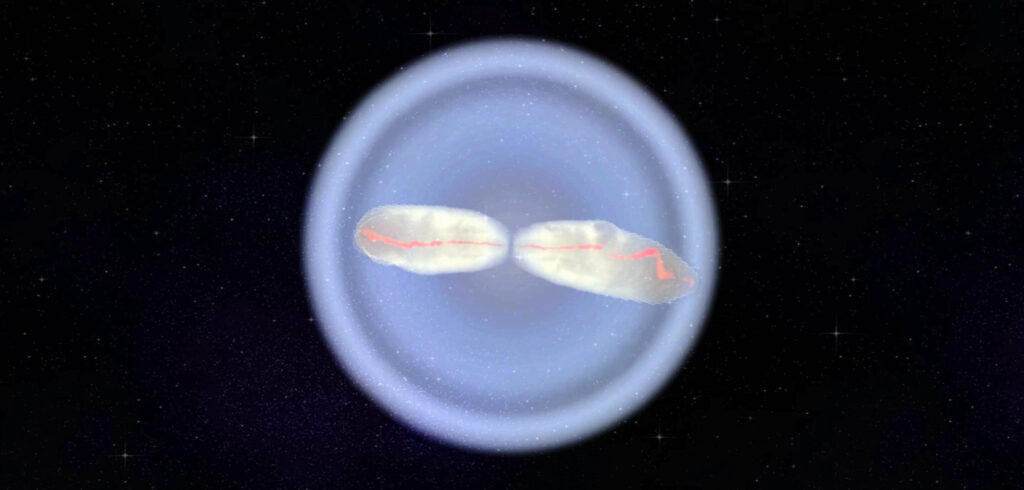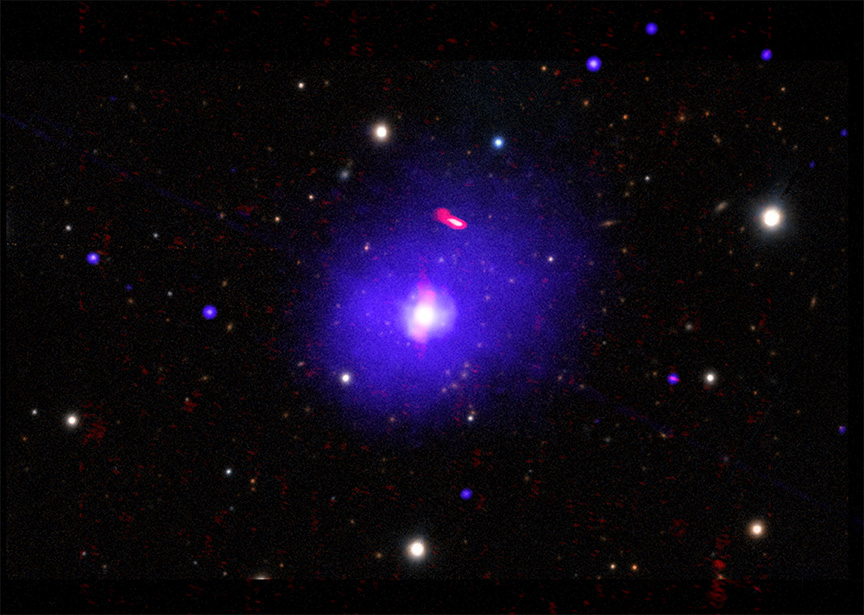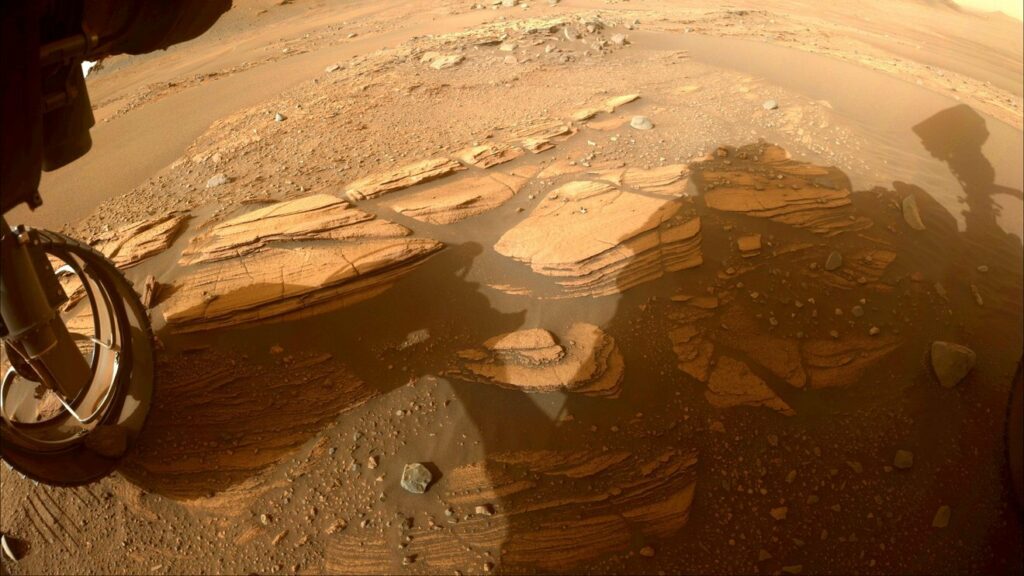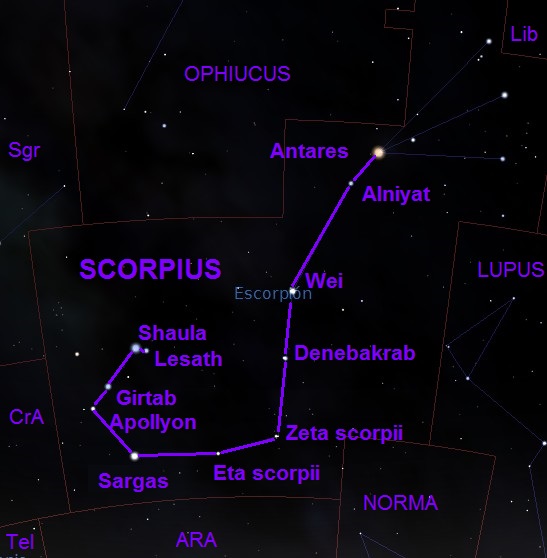A trio of stories examines the possibilities for finding life in strange, new places, including deep underground here on Earth, in the subsurface oceans of Europa, and fossilized within sedimentary rocks on Mars. Plus, a SpaceX launch, gamma-ray bursts, and this week’s What’s Up.
Podcast
Show Notes
SES-22 satellite launches on Falcon 9
- Thales Alenia Space press release
- SES-22 mission page (SpaceX)
Wibbly wobbly black hole formation
- Northwestern press release
- “Black Hole to Photosphere: 3D GRMHD Simulations of Collapsars Reveal Wobbling and Hybrid Composition Jets,” Ore Gottlieb et al., 2022 June 29, The Astrophysical Journal Letters
Slow roll for big black hole
- CXO press release
- CXO photo release
- “Evidence for a moderate spin from X-ray reflection of the high-mass supermassive black hole in the cluster-hosted quasar H1821+643,” Júlia Sisk-Reynés, Christopher S. Reynolds, James H. Matthews, and Robyn N. Smith, accepted to Monthly Notices of the Royal Astronomical Society (preprint)
Small robots could explore other planets’ oceans
- NASA JPL press release
Groundwater aquifers host thriving microbial ecosystem
- iDiv press release
- “Carbon fixation rates in groundwater similar to those in oligotrophic marine systems,” Will A. Overholt et al., 2022 June 30, Nature Geoscience
The sedimentary rocks of ‘Enchanted Lake’, Mars
- NASA JPL press release
New outbursts discovered regularly
- Astronomers detect a new cataclysmic variable system (Phys.org)
- “TUVO-21acq: a new cataclysmic variable discovered through a UV outburst,” David Modiano et al., accepted to Astronomy & Astrophysics (preprint)
What’s Up: Early July Evenings
- Visible planets and night sky guide: July 2022 (EarthSky)
- Scorpius (Sea and Sky)
Transcript
Well, SpaceX managed to launch another satellite that wasn’t Starlink.
That’s good. I still worry about how these satellite constellations will affect science observations.
Fair. At least they don’t impact us getting spacecraft to other worlds.
True. And we’re still observing a lot of cool, interesting objects regardless – including cataclysmic variable stars.
Those sound fun.
They are!
Plus we have a bunch of stories on searching for life in our solar system, and I’ll tell you what’s up in the night sky.
All of this and more, right here on the Daily Space.
I am your host Dr. Pamela Gay.
I am your host Erik Madaus.
And we’re here to put science in your brain.

SpaceX launched their 27th mission of the year on June 28 at 21:04 UTC. A Falcon 9 1073 lifted SES-22 into Geostationary Transfer Orbit, GTO, from SLC-40 in Florida.
Most Falcon 9 missions end 10-15 minutes after launch, but SES-22’s GTO orbit required quite a long coast phase to do the next second stage burn at the equator, so the mission ended with payload separation 28 minutes into the flight, with the host signing off while the satellite was visible floating away from the upper stage cameras.
Booster 1073 successfully completed its second landing on A Shortfall of Gravitas ten minutes into the flight.
SES-22 is an interesting satellite in comparison to the large crowd of other geostationary communications satellites. It has transponders that use C-band – between 3.7 to 4.2 Gigahertz – and not Ka, Ku, or X-band like other satellites. C-band was the first band that satellite communications were authorized to use. The other bands came later after technology improved because the higher frequencies are more easily blocked by precipitation.
The reason this particular satellite uses this bandwidth is the subject of a lot of politics and drama. What you need to know is that several geostationary satellite operators worked with the Federal Communications Commission – the government agency responsible for frequency assignments – to give up some 280 megahertz of their C bandwidth so terrestrial operators could use those frequencies in 5G cell phone towers across more of the US.
SES-22’s cousins, SES-20 and 21, are of a different satellite design but also with C-band payloads and will launch together on an Atlas V later this year. SES-18 and 19 will do the same on a Falcon 9 in the same time period.

My entire professional life, I’ve heard people saying we live in a Golden Age for astronomy. From the development of the digital camera to the repair of Hubble, down through the launch of NASA’s great observatories, and on toward the construction on the ground of so many great big telescopes and telescope arrays, we have had three decades of rapid evolution in our understanding of the sky that was brought about by advances in technology. When satellite companies aren’t bickering over bandwidth, we can celebrate everything we have learned.
But it is sometimes more interesting to celebrate the things we discovered by haven’t yet figured out. Since the 1990s, astronomers have been able to capture the transitory optical light that shines from the locations of gamma-ray bursts (GRBs). These literally shining moments have let us figure out that multiple kinds of objects create gamma-ray bursts that last for variable amounts of time. The longer ones, which can last for hundreds of seconds, seem to be associated with supernovae explosions, but exactly why some but not all supernovae have gamma-ray bursts is a curious matter.
Observationally we know these systems beam an inconstant beam of gamma rays toward us, and otherwise don’t look exceedingly different from other supernovae. One school of thought has GRBs coming from systems with a single massive star that is collapsing downward. The problem with this theory is it predicts fewer gamma-ray bursts than we see. It also doesn’t explain the changes in gamma-ray brightness during the event.
But what we can explain and figure out on paper or in simple models is often missing major details, and in the most sophisticated model today, a team led by Ore Gottlieb simulated a dying star collapsing into a black hole and discovered those missing details explain both the scarcity of GRBs and their wandering brightness. As Gottlieb explains it: These jets are the most powerful events in the universe. Previous studies have tried to understand how they work, but those studies were limited by computational power and had to include many assumptions. We were able to model the entire evolution of the jet from the very beginning—from its birth by a black hole—without assuming anything about the jet’s structure. We followed the jet from the black hole all the way to the emission site and found processes that have been overlooked in previous studies.
In their supercomputer requiring simulation, they could see that as a star collapses, material forms a disk that drives jet formation, but that disk is getting hit asymmetrically by infalling materials, and that force can tip and tilt the disk, sending the gamma-ray beam in and out of our view. This wobble also means that we can see gamma-ray bursts from more angles than if they just sat there sputtering, so a smaller number of objects are needed to explain all the GRBs we see.
I’m sure this isn’t the final word on how GRBs form, but it is one of the best theories we have at the moment. And it may be that there is more than one cause. As new ideas and new observations come in, we’ll bring them to you here on the Daily Space.
Understanding our sky is really a multi-wavelength affair. From gamma-ray bursts, we now turn toward X-ray bright black hole environments.

While black holes don’t emit light, the material falling toward their event horizon will form a disk that can grow in size until it is dense enough to ignite with nuclear reactions. These disks in actively feeding galaxies and the innermost stars in starving systems like our Milky Way’s Sgr A* let us measure the speeds of objects near the event horizon of the black hole, and those speeds are influenced by the rate the black hole itself is spinning. This is because a spinning black hole can literally drag space-time around with it.
In new observations of the quasar H1821+643, researchers have discovered this actively spinning system is rotating more slowly than expected. At thirty billion solar masses, this is a massive system that dwarfs our galaxy’s four million solar mass black hole. And while our black hole rotates at a pace that isn’t too different from other similarly sized behemoths, this supersized supermassive black hole is lumbering around at a much slower rate. This difference is consistent with supermassive black holes growing over time through the merger of small galaxies and their smaller supermassive black holes. Since these mergers happen from all sorts of different directions and angles, they will typically slow the rotation of the black hole as systems chaotically merge.
Conveniently, this matches theory, and science appears to be marching on with one really big thing making sense.
Next up, we switch from what we see to how we will one day see it as Erik brings us tales of water robots.

For a long time, science has known that several of the moons of the outer planets probably have oceans. Now technology is under development that will allow a spacecraft to explore them. One of the perennial problems with space exploration is that rockets can only accelerate so much to the outer planets, so spacecraft cannot be too big. This limits the amount of science that can be done.
A new idea from NASA’s JPL is to use lots of very small robots, which will be delivered through the ice of an ocean world to explore it in detail. The robots will also allow studying the likely gradients in the ocean by flying in formation, taking slightly different data depending on their position. Such gradients are possible signs of life, according to the engineer in charge of the proposal, Ethan Shaler.
The advantage of small robots is that they will maximize the amount of area covered under the ocean. If a single stationary robot lands where there’s nothing interesting in range, the mission will have returned nothing. Also, the under-ice probe uses a radioisotope thermoelectric generator (RTG) to melt the ice, and that could change the possible results, so getting away from the probe is best.
The idea of the robot swarm is fairly risky, but some of that risk is reduced by the sheer number of robots – four dozen twelve-centimeter robots. Some of them could fail, but since each can function independently, science could still be done despite any individual failures. The small volume lets other instruments fit in the under-ice probe as well, maximizing science.
Shaler first developed this concept under a Phase 1 NASA Innovative Advanced Concepts grant. He received a Phase 2 grant this year to further advance the concept and create a few prototypes. In the 2030s, a lander may visit Europa’s surface, after the Europa Clipper orbiter visits it earlier in the decade. Europa Clipper is currently scheduled for a 2024 launch, arriving in 2030.

Okay, say we get our spacecraft and probes to Europa or some other icy world. What makes us think that life is even possible on these distant, shadowed, frozen worlds? Over the past few decades, scientists have been searching for life here on Earth in the wildest of places to see if life is possible just about everywhere, and the answer keeps turning out to be yes.
Now, in a new paper in Nature Geoscience, scientists have published the findings of samples taken of groundwater in a subsurface aquifer located between five and ninety meters below ground. Yes, life exists in water, but this team wanted to know if life could exist in water that gets no sunlight at all. Specifically, they looked for microbes that could carry out carbon fixation – chemosynthesis of carbon – to grow their biomass. And they found such microbes and a surprisingly high rate of carbon fixation as well. Lead author Will Overholt explains: The rates we measured were much higher than we anticipated. They equal carbon fixation rates measured in nutrient-poor marine surface waters and are up to six-fold greater than those observed in the lower zones of the sunlit open ocean, where there is just enough light for photosynthesis.
The microorganisms responsible for all this carbon fixation turned out to be uncharacterized and not closely related to any previously studied bacteria. Overholt notes: As food, these organisms are thought to form the basis of life for the entire groundwater ecosystem with all of its thousands of microbial species, similar to the role algae play in the oceans or plants on land.
So there is an entire functioning ecosystem in our groundwater that’s going to require a lot more research to understand. Amazing.

Speaking of looking for signs of life, a recent image taken by the Hazcam on NASA’s Perseverance rover is intriguing and exciting to planetary scientists and astrobiologists alike. The image shows a region now informally named ‘Enchanted Lake’ and is the first close-up image of the sedimentary layers at the base of the river delta in Jezero Crater. The delta sits where a Martian river flowed into the crater lake billion of years ago, and scientists have wanted to study it since Jezero was announced as the landing site.
When Percy landed in Jezero, an early analysis of the rocks around the landing zone revealed that the crater floor was made of igneous rocks. That’s great for understanding the interior of Mars and the age of geologic features, but rocks that formed under extreme heat aren’t exactly a great place to go hunting for signs of microbial life.
Then again, considering the wild places we keep finding life, we could be wrong about that, too. But I digress.
We’re not expecting to find current life in Jezero crater. We’re looking for fossilized life, and the best place to find fossils is in sedimentary rocks. As mud, silt, and sand is carried down rivers, such as the one that fed this crater lake, it is deposited on top of all that igneous rock. If microbial life existed on Mars, it could have been carried within the river water as well and been preserved within the layers of sediment. That sediment then became compacted and cemented into rock, and those fossilized lifeforms could still be there.
That is a lot of ‘if’ and ‘could’. Honestly, we won’t know until we can bring some sedimentary rock samples back to Earth in the Mars Sample Return campaign, which is planned for sometime in the 2030s. In the meantime, Percy is going to analyze and maybe even sample some sedimentary rocks in an area called ‘Hogwallow Flats’, but the team may have the rover return to ‘Enchanted Lake’ later this year.
Before we get to this week’s What’s Up, we’re going to talk about some really interesting stars.

Our universe is full of things that flicker and flare in the night. From the powerfully energetic gamma-ray bursts to out-bursting comets, these flashes are driven by all manner of physics. One of my favorite kinds of outbursts is the cataclysmic variable (CV). These systems consist of one compact white dwarf star that is gravitationally drawing material off a companion star. When the white dwarf builds up enough stolen material, it will detonate, and we can see the light show across the wavelengths of light.
The Swift telescope is currently being used to find cataclysmic variable stars in the ultraviolet, and on June 21, they published the discovery of a system cataloged as TUVO-21aq. Located on the sky near the galaxy NGC4945, this is a galactic object that was found because Swift was looking at another galaxy. While not the most exciting cataclysmic variable ever discovered, this object shows that ultraviolet observations can uncover unknown objects in the background of other observational targets.
Discovering CVs isn’t just for the pros with the space telescopes. It is also something that is done by backyard astronomers. From finding new outbursts to monitoring for the newest outburst of known CVs, dedicated folks with small scopes can play an important role.
If you are a person with a telescope and a camera, you can take part in this science. Check out the American Association of Variable Star observers to learn more at AAVSO.org.
What’s Up

This week in What’s Up is what you can expect to see in the evenings early in July.
On July 7, the Moon will both be in its first-quarter phase and in the constellation Virgo. First-quarter is, of course, the best time to see the Moon’s surface in detail but is also not the worst time to see the plenty of deep sky objects in Virgo as well. The Moon’s brightness will wash out some details but not as bad as compared to the Full Moon.
A few days later, also in the evening, on July 10, the Moon will pass near Antares in Scorpius. Scorpius is one of my favorite constellations because it has many optical and true double stars including Nu Scorpi and Omega Scorpi. Scorpius also has open clusters aplenty, including Messier 6 and 7. A lot of people consider these boring, but I quite like them at medium power in a small telescope. Scorpius also has two Messier globular clusters – Messier 4 and Messier 80. These are best viewed at higher power.
So whether you enjoy gazing at the Moon, perusing the Messier catalog, or hunting for cataclysmic variable stars, astronomy has something for everyone. Remember to go outside tonight and look up.
This has been the Daily Space.
You can find more information on all our stories, including images, at DailySpace.org. As always, we’re here thanks to the donations of people like you. If you like our content, please consider joining our Patreon at Patreon.com/CosmoQuestX.
Credits
Written by Pamela Gay, Beth Johnson, Erik Madaus, and Gordon Dewis
Hosted by Pamela Gay, Beth Johnson, and Erik Madaus
Audio and Video Editing by Ally Pelphrey
Content Editing by Beth Johnson
Intro and Outro music by Kevin MacLeod, https://incompetech.com/music/


 We record most shows live, on Twitch. Follow us today to get alerts when we go live.
We record most shows live, on Twitch. Follow us today to get alerts when we go live.